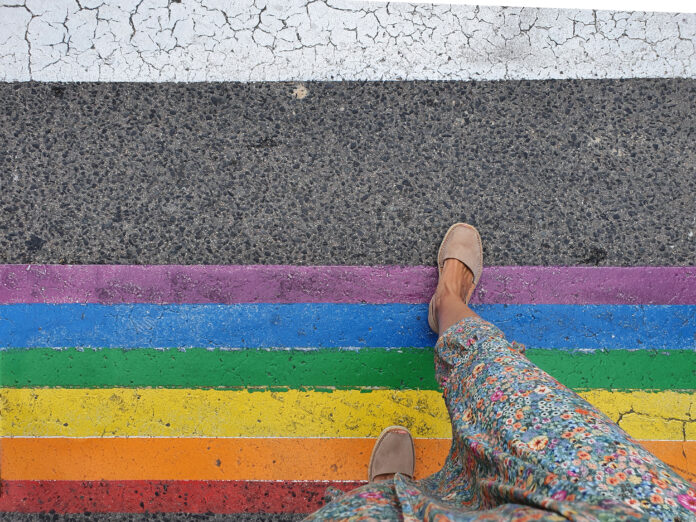Picture this: a 17-year-old girl has accepted her lesbian identity. She immerses herself into lesbian culture, learning all the terminology and history. Suddenly, she is hit with a rude awakening that there is far more hardship in belonging to the LGBTQ+ community than merely accepting herself. She is also ostracized by not only straight people but also other LGBTQ+ people for being too feminine, and even accused of lying about her sexuality. The very identity she has found solace in is constantly invalidated, as it does not fit society’s standards of what a lesbian looks like. This is my personal experience, and only one voice of many in the lesbian community who are experiencing identity erasure by heteronormative standards.
The American Psychological Association defines heteronormativity as the “assumption that heterosexuality is the standard for defining normal sexual behavior and that male–female differences and gender roles are the natural and immutable essentials in normal human relations.” Beyond the assumption that all relationships are heterosexual, heteronormative standards are also reinforced when people believe that lesbian relationships — specifically masc/femme relationships — need to fulfill male/female gender roles or resemble straight relationships.
The rhetoric that lesbian identities and relationships can only be understood through a heterosexual, gender binary lens is harmful and offensive. Ultimately, this perspective misconstrues the importance that certain terms, such as “masc” and “femme,” have in the lesbian community. The LGBTQ+ community and its allies need to adopt a more inclusive viewpoint on the subject and start accepting that lesbians can identify and express themselves in a variety of ways.
The terms “masc/butch” and “femme” have been used for decades to identify categories of lesbian presentation. Mascs/butches are lesbians or queer women that dress, appear or identify as more masculine. Likewise, femmes are lesbians or queer women that present themselves more femininely.
Historically, lesbians have had a binary, heteronormative form of expression with the goal of appearing straight in order to stay safe. The terms butch and femme were coined during the ‘40s and ‘50s and were originally used as safety measures to deter undercover cops, since openly presenting as a lesbian couple ran the risk of persecution. Masculine lesbians dated feminine lesbians and passed through society as men, making it easier to avoid the social stigmas that would otherwise prevent them from getting a job.
In recent decades, these terms now serve as a form of inclusive lesbian identity and empowerment. While initially serving to hide lesbian relationships, these terms are now intended to celebrate them. Great diversity is now seen in lesbian communities. These identities serve as ways for lesbians to proudly and uniquely express themselves in a world where being heterosexual is the norm. Reminding lesbian youth that they belong no matter where they land on the spectrum is crucial to their development and happiness.
Unfortunately, lesbians are still unable to freely express their identities without the scrutiny of heteronormative stereotypes. In an interview with Cosmopolitan, Rachel — a person in a masc/femme relationship — shared that mascs were expected to “handle the finances or be more dominant and take more of an assertive role.” Rachel perceived this stereotype to be sexist and a “product of the patriarchy,” much like the heteronormative standards that were forced upon lesbians in the ‘40s.
Cosmopolitan also interviewed Hannah — a feminine presenting lesbian — who experienced people “shouting homophobic things” at her, simply because they didn’t believe she was gay. She experienced aggression simply because she did not meet the standard of appearing masculine as a lesbian. Despite this, her relationship with her girlfriend was described as “equal,” with neither taking charge. This fights the stereotype that the masculine lesbian takes charge in a relationship like a man would.
Gender stereotypes are generally sexist and harmful even when it concerns straight relationships. For example, the belief that men are the breadwinners and women are the caretakers place restrictive standards on straight couples. However, when gender stereotypes are projected onto lesbian relationships, it cuts even deeper. Lesbian identities are “developed personally and across international discourses.” They are not “straightforward” and “can mean different things for different people.”
Saying that a masc/femme relationship is mimicking a male/female relationship is essentially saying that lesbian relationships are deviant of straight relationships. At the same time, it also erases decades of using “masc/butch” and “femme” as terms of safety for lesbians. Though this can be seen as complacency with heteronormativity, it is still an important part of lesbian history. We can acknowledge the historical role that these identities played in keeping lesbians safe and alive while also appreciating how lesbians now have more freedom to express their identities without having to appeal to heterosexual norms.
We must work towards decreasing heteronormativity by encouraging LGBTQ+ youth to voice their opinions and identify with what makes them comfortable. Instead of pushing gender norms and heterosexual behavior upon lesbians, society should help foster a society where all lesbian relationships, identities and forms of expression are welcome and heard.
Lindsey Blake is an Opinion Intern for the winter 2023 quarter. She can be reached at lgblake@uci.edu.

